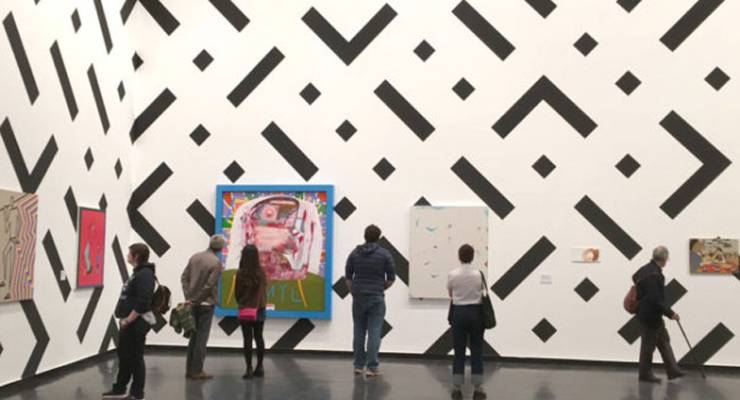
“Painting is dead,” said Paul Delaroche in 1839, a French painter ironically best known for his fateful quote. That was the year the world was introduced to the daguerreotype, the photograph as we know it.
Recently Fairfax art critic Robert Nelson wrote:
“Painters and curators know that painting is dead but have powerful incentives to believe that it might be revived.”
But I say, No! Painting lives! And it will outlive all its critics. Nobody asks why singers sing and tells them to stop, or criticises dancers for dancing. Or tells children to stop drawing and sloshing paint around — “Darlings, painting is dead, we must use new media now.” Has anyone advised the elders in Arnhem Land to tell their people to stop all that daubing? That they need to get some tech to plug and play?
Paintings happen because painting — like modelling forms in clay, like sounding notes by voice or object — is a prehistoric cultural meme. It flourished before the glories of text. How pompously can I put it? To paint is one way to be human.
Painting: Dead? Not dead? (See cute Google Trend chart). Beyond one smallish corner of the art world, no-bo-dy cares. At the moment we have a painting show at Australian Centre for Contemporary Art (ACCA) — an A-Z rollcall of painting worthies, young and old. A big Degas show just finished at the NGV, which now hosts a big retrospective of John Olsen, the grand seigneur of Australian painting.
Beyond the city, there’s the Geelong Contemporary Art Prize — exclusively painting. Hamilton has shows of Streeton, John Wolseley and young Will Mackinnon, three painters across overlapping time spans, and Horsham just concluded a show of five contemporary painters. Both Bendigo and Ballarat galleries are having their drawing prize shows, which not only have strong affinities to painting, but also include quite a bit of painting-drawing. And, of course, commercial galleries are awash with painting.
As a hip gallerist was overheard to say at the TarraWarra Biennial, “I like things that can be bought and sold and hung on a wall”. And market-wise, public-wise, it seems most people not on the cutting edge of art conversations agree. That need not worry artists, curators, critics and edgy gallerists. There is room for everyone, and if we were all in the avant-garde (now, there’s a dead term) then where would the cool crowd go?
The critic writes
There’s a fun if acidic conversation going on at the moment between Fairfax critic Robert Nelson and the painters Gareth Sansom and John Kelly. Nelson has slagged off (an accurate localism) both the ACCA painting and John Olsen shows. Nelson may have offered some faint praise to Olsen and gold stars to a few artists at ACCA, but he did not like the shows. He was professionally critical, or plainly insulting — in any case he had strong opinions.
On the ACCA show: “Nowadays, most painters lack most skills in painting … Painters and curators know that painting is dead but have powerful incentives to believe that it might be revived.”
On Olsen: “The more John Olsens that you put into a room, the uglier it becomes … The best paintings with their tangle of tentacles are only mildly entertaining. They have little profundity.”
The painters reply
Gareth Sansom is one of the artists currently at ACCA — about 10 years ago in the Australian, Sebastian Smee, now the Pulitzer-prize winning art critic for the Boston Globe, called him “for my money, the most exciting painter in Australia today”. On Saturday September 17, addressing a sizeable audience in front of his ACCA painting, Sansom took a swipe: “Periodically there is some idiot saying, Painting is dead. In fact, some idiot in the Age is saying it every five years.”
John Kelly, in Daily Review, offers a passionate defence of painting, and points out that video art (which Nelson had mentioned favourably over painting) was at this moment more like old hat than new tech. And he suggests that Nelson may be playing a theatrical provocateur parading a Look-At-Me routine. Anyway, Kelly also asks some pertinent questions:
“Should any medium be separated by a kind of artistic apartheid? Will ACCA present similar exhibitions based on sculpture, printmaking or installation/video art? Is painting part of a broader contemporary culture or does it have a special status, given its longevity as the Methuselah of Art? Does this separation elevate or undermine its artistic currency that continues to turn in its grave despite the regular last rites proffered?”
My gallery has many rooms
Pardon the Biblical allusion (John 14:2) prompted Methuselah, but here’s the thing — outside the white cube, nobody cares if painting is dead. Because people like painting. That is why, for instance, the perennially panned Archibald Prize is such a big deal. And why the Portrait Gallery in Canberra draws visitors. They show images of recognisable subjects in a time-honoured medium, visibly wrought with artisanal labour. (Indicatively, the ACCA and Geelong shows are pretty evenly divided between abstraction and figuration.) One hundred years on from the dawn of Modernism and the peak of Cubism, people are still adjusting. As William Gibson wrote, “The future is already here — it’s just not evenly distributed.”
The celebrated David Hockney — a painting holdout despite his fondness for adopting tech — with a show slated later this year at the NGV, was talking about good and bad painting to an interviewer when he was interrupted for his opinion about art. Hockney said something to this effect: “We were talking about painting, but art, now, that’s a much bigger subject.” Which is to say, painting is a practice which is art, but also one that goes on regardless of “art”. People will keep looking at paintings, and people will keep making paintings whether or not people look at it. To paint is to be human.
There is room for art in the wretched craziness of the human world, and room in the art world for all kinds of painting.








Yes, even the most unemployable young dropkicks, deprived of any worthier challenge in life, paint their tags on the city walls. For that matter, the best protection (short of automated shotguns) against graffiti appears to commission a trained artist to paint a mural on the wall, and hope that a universal respect for painting allows the mural to survive.